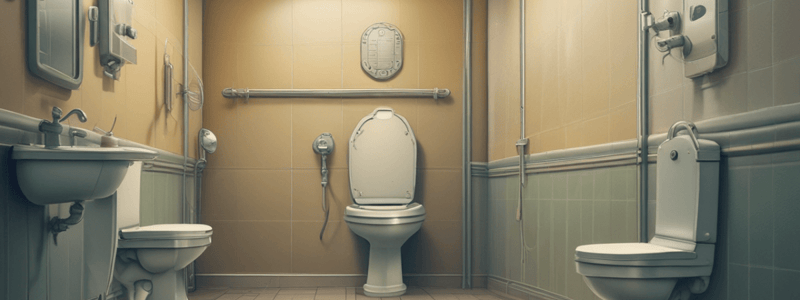Podcast
Questions and Answers
Which of the following factors is least likely to affect urinary elimination?
Which of the following factors is least likely to affect urinary elimination?
- Genetic predisposition (correct)
- Food and fluid intake
- Psychological variables
- Medications
What is a common nursing diagnosis related to urinary problems in elderly patients experiencing increased frequency?
What is a common nursing diagnosis related to urinary problems in elderly patients experiencing increased frequency?
- Ineffective urinary elimination
- Risk for impaired skin integrity
- Urinary incontinence (correct)
- Fluid volume deficit
Which intervention is NOT recommended for promoting normal urination?
Which intervention is NOT recommended for promoting normal urination?
- Using bladder training techniques
- Limiting fluid intake before bed (correct)
- Providing frequent opportunities for toileting
- Encouraging adequate fluid intake throughout the day
What is an effective nursing intervention to manage urinary incontinence?
What is an effective nursing intervention to manage urinary incontinence?
Which of the following is NOT a factor that contributes to the risk of urinary tract infections?
Which of the following is NOT a factor that contributes to the risk of urinary tract infections?
Which physiological change is often experienced by the elderly affecting urination?
Which physiological change is often experienced by the elderly affecting urination?
Which goal is the primary focus for a patient-centered plan for a nursing diagnosis of urinary retention?
Which goal is the primary focus for a patient-centered plan for a nursing diagnosis of urinary retention?
Which nursing intervention is most effective in preventing urinary tract infections in patients?
Which nursing intervention is most effective in preventing urinary tract infections in patients?
Which statement correctly identifies a developmental consideration for children regarding urination?
Which statement correctly identifies a developmental consideration for children regarding urination?
Which urinary output level would typically prompt concern in clinical assessment?
Which urinary output level would typically prompt concern in clinical assessment?
Which factor is least likely to promote normal voiding habits?
Which factor is least likely to promote normal voiding habits?
What is a primary reason for catheterization related to patient care?
What is a primary reason for catheterization related to patient care?
Which of the following is a significant risk factor for urinary tract infections in females?
Which of the following is a significant risk factor for urinary tract infections in females?
Which intervention is most effective in managing urinary incontinence?
Which intervention is most effective in managing urinary incontinence?
What does the presence of pink urine most commonly indicate?
What does the presence of pink urine most commonly indicate?
Which self-care behavior is essential for patients undergoing urinary diversion?
Which self-care behavior is essential for patients undergoing urinary diversion?
What combination of factors is most likely to affect urination negatively?
What combination of factors is most likely to affect urination negatively?
Which of the following actions is least effective in promoting normal urination?
Which of the following actions is least effective in promoting normal urination?
In critically ill patients, what is an indication for using a catheter?
In critically ill patients, what is an indication for using a catheter?
Which of the following urine colors typically indicates dehydration?
Which of the following urine colors typically indicates dehydration?
Which assessment is NOT typically included in the physical examination of urinary functioning?
Which assessment is NOT typically included in the physical examination of urinary functioning?
What is a key factor to explore when assessing a problem with voiding?
What is a key factor to explore when assessing a problem with voiding?
Which urine color is indicative of concentrated urine?
Which urine color is indicative of concentrated urine?
Which of the following factors is NOT considered an influencing variable on urination?
Which of the following factors is NOT considered an influencing variable on urination?
What would be the most effective intervention to manage urinary incontinence?
What would be the most effective intervention to manage urinary incontinence?
Which of the following urine assessments would indicate a potential urinary tract infection?
Which of the following urine assessments would indicate a potential urinary tract infection?
When assessing a patient for adequacy of self-care behaviors regarding voiding, which aspect is least important?
When assessing a patient for adequacy of self-care behaviors regarding voiding, which aspect is least important?
During the assessment of urinary function, which is NOT part of the skin assessment?
During the assessment of urinary function, which is NOT part of the skin assessment?
In the context of urinary diagnostics, which finding is most concerning?
In the context of urinary diagnostics, which finding is most concerning?
Which statement about promoting normal urination is most accurate?
Which statement about promoting normal urination is most accurate?
Which type of urinary incontinence is characterized by involuntary loss of urine due to increased intra-abdominal pressure?
Which type of urinary incontinence is characterized by involuntary loss of urine due to increased intra-abdominal pressure?
What nursing diagnosis is used to describe an inability to completely empty the bladder?
What nursing diagnosis is used to describe an inability to completely empty the bladder?
In what situation might a risk for urge urinary incontinence diagnosis be appropriate?
In what situation might a risk for urge urinary incontinence diagnosis be appropriate?
Which intervention can help promote normal urination and bladder control?
Which intervention can help promote normal urination and bladder control?
What is a major potential complication of inadequate management of urinary incontinence?
What is a major potential complication of inadequate management of urinary incontinence?
Which of the following is NOT considered a type of urinary incontinence?
Which of the following is NOT considered a type of urinary incontinence?
What is a common factor that contributes to transient urinary incontinence?
What is a common factor that contributes to transient urinary incontinence?
Which nursing intervention is focused on preventing urinary tract infections?
Which nursing intervention is focused on preventing urinary tract infections?
What is a potential outcome for an individualized patient goal regarding urinary function?
What is a potential outcome for an individualized patient goal regarding urinary function?
Which type of urinary incontinence can cause a sudden and intense desire to urinate, leading to frequent bathroom visits?
Which type of urinary incontinence can cause a sudden and intense desire to urinate, leading to frequent bathroom visits?
Flashcards are hidden until you start studying
Study Notes
Promoting Normal Urination
- Key strategies include maintaining normal voiding habits, fluid intake promotion, muscle tone strengthening, and assisting with toileting.
Maintaining Normal Voiding Habits
- Establish a regular schedule for urination.
- Respond promptly to the urge to void.
- Ensure privacy during the process.
- Choose comfortable seating positions.
- Promote good hygiene practices.
Reasons for Catheterization
- Indicated for urinary retention or prolonged patient immobilization.
- Necessary for obtaining urine specimens and accurate output measurement in critically ill patients.
- Aids healing in incontinent patients with open wounds.
- Provides comfort in end-of-life care and during surgeries.
Risk Factors for UTIs
- Higher incidence in sexually active females using diaphragms and post-menopause.
- Increased risk associated with catheter use and comorbidities affecting the immune system.
- Factors leading to urinary stasis in the bladder contribute to the risk.
Patient Education for Urinary Diversion
- Clearly explain the reason and treatment rationale for urinary diversion.
- Demonstrate effective self-care behaviors for patients.
- Discuss follow-up care and community support resources.
- Address patient fears and concerns; encourage a positive body image.
Urine Color Implications
- Pink urine may indicate blood presence.
- Tea-colored urine could suggest liver issues or hematuria.
- Orange urine might result from dehydration or certain medications.
- Black urine may indicate melanin presence or medication side effects.
- Blue urine is relatively rare and can be due to certain dyes or medications.
Urinary Incontinence
- Often underdiagnosed and can significantly impact quality of life.
- Not a normal consequence of aging; often manageable through proper interventions.
Types of Urinary Incontinence
- Functional: Caused by external factors, not bladder issues.
- Overflow: Results from bladder overdistention.
- Reflex: Involuntary bladder emptying without sensation.
- Stress: Urine loss due to increased abdominal pressure.
- Urge: Sudden, intense urge to urinate due to overactive bladder.
- Additional types include Total, Mixed, and Transient incontinence.
Nursing Diagnoses
- Impaired urinary elimination and various types of urinary incontinence.
- Risk for urinary retention and incontinence.
Devices for Urine Collection
- Utilize suprapubic catheters for bladder positioning.
Planned Patient Goals
- Achieve a sufficient urine output to maintain body balance.
- Completely empty the bladder regularly without discomfort.
- Manage urinary diversion and seek professional notification when necessary.
- Alter unhealthy urinary habits.
Factors Influencing Micturition
- Developmental stages, food/fluid intake, psychological factors, activity levels, medical conditions, and medications.
Developmental Considerations
- Children typically begin toilet training by age 2-3.
- Aging affects micturition: increased nocturia, frequency, urine retention, and diminished voluntary control.
Assessing Urinary Functioning
- Use interviews and physical assessments to evaluate voiding patterns.
- Correlate findings with diagnostic tests.
Physical Assessment Techniques
- Palpate kidneys, bladder; assess skin for hydration.
- Inspect urethral orifice for signs of infection.
- Evaluate urine for color, clarity, and odor.
Nursing Assessment Vocabulary
- Use specific terms to describe voiding patterns, urine appearance, bladder condition, and catheter type.
Studying That Suits You
Use AI to generate personalized quizzes and flashcards to suit your learning preferences.





